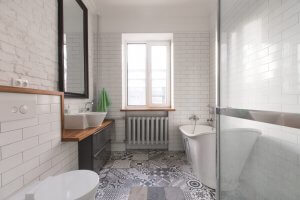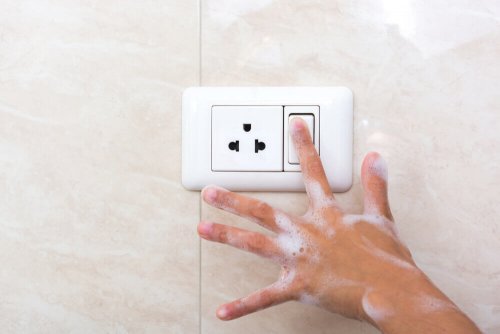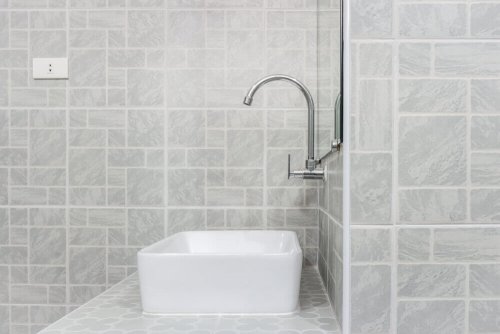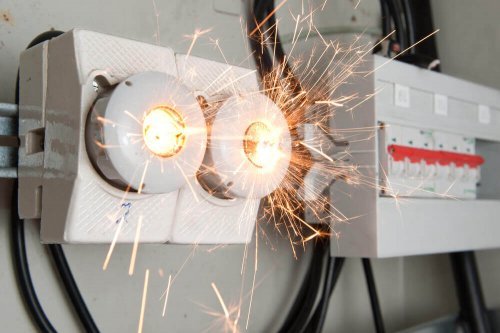Electrical Wiring Requirements for a Bathroom

Of all the rooms in the house, the bathroom can be the most dangerous. That’s why you should pay special attention to the electrical wiring requirements during installation. It will help you avoid any potential accidents. You also have to take into account the potential danger during installation and using any electrical elements.
So you can enjoy your bathroom in complete safety and comfort, we’ll explain all the electrical wiring requirements that you need to meet in a bathroom.
Electrical wiring requirements and humidity

Everyone knows that electricity and water are a bad combination. On the other hand, when installing a bathroom, you have to use both. Electricity is essential for lighting and for appliances, such as hairdryers, electric razors, or straighteners. Water is also a main element of the bathroom. Without water, the room isn’t functional.
As a result, it’s necessary to put these elements together, although it can be dangerous. An electric shock is caused when electricity and water come into contact. The potential danger will depend on the intensity of the electricity and the humidity level. For example, touching a powerstrip with wet hands isn’t the same as dropping a hair straightener into a bathtub. The outcome can be deadly.
We recommend that you never install electrical wiring in the bathroom yourself. The only exception is if you have professional knowledge. A professional is the only person who is capable of doing electrical wiring and complying with electrical wiring requirements. This is essential for your family’s safety.
In the case of installation errors, it can be doubly dangerous. On the one hand, an electric shock can occur during installation. On the other hand, it can happen if there is a problem with the installation. A shock can happen after the work has been completed.
Bathroom zones

Firstly, when installing electrical wiring, you have to consider bathroom zones. These indicate where the most dangerous areas are. You should, therefore, avoid installing any electrical elements in the dangerous zones. Bathroom zones are numbered according to the danger level. They are as follows:
- Zero. This is the most dangerous area and no electrical element should be present under any circumstances. This corresponds to the interior of the bathtub or shower.
- One. This is the vertical walls that are in contact with the shower or bathtub up to a distance of about 7 feet. This level is not extremely dangerous, but we still don’t recommend you install any electricity. However, in some cases, people install electric showers.
- Two. This covers from the end of zone one to three feet beyond. You can install low voltage elements, such as switches or sockets, in this area.
- Three. This is the last zone and allows for the installation of more electrical elements. It covers 10 feet from the bathtub and at a height of 7 feet.
Earthing is essential

As you’ve seen throughout this article, the bathroom can be a very dangerous place when it comes to electricity. That’s why it’s essential you follow all electrical wiring requirements and safety measures to avoid anything that could cause a serious accident.
To put it simply, in basic electrical installation, the current passes through the wire to the main element, like a light bulb. Then it returns to the generation. If there is a problem in the installation, however, a small discharge can occur.
This style of error can’t happen in a bathroom. Since water is also present, it can cause large and dangerous discharges. To ensure safety, you’ll need to install an earth connection. That way, you can avoid electric shocks and protect your family from any mishaps.
Of all the rooms in the house, the bathroom can be the most dangerous. That’s why you should pay special attention to the electrical wiring requirements during installation. It will help you avoid any potential accidents. You also have to take into account the potential danger during installation and using any electrical elements.
So you can enjoy your bathroom in complete safety and comfort, we’ll explain all the electrical wiring requirements that you need to meet in a bathroom.
Electrical wiring requirements and humidity

Everyone knows that electricity and water are a bad combination. On the other hand, when installing a bathroom, you have to use both. Electricity is essential for lighting and for appliances, such as hairdryers, electric razors, or straighteners. Water is also a main element of the bathroom. Without water, the room isn’t functional.
As a result, it’s necessary to put these elements together, although it can be dangerous. An electric shock is caused when electricity and water come into contact. The potential danger will depend on the intensity of the electricity and the humidity level. For example, touching a powerstrip with wet hands isn’t the same as dropping a hair straightener into a bathtub. The outcome can be deadly.
We recommend that you never install electrical wiring in the bathroom yourself. The only exception is if you have professional knowledge. A professional is the only person who is capable of doing electrical wiring and complying with electrical wiring requirements. This is essential for your family’s safety.
In the case of installation errors, it can be doubly dangerous. On the one hand, an electric shock can occur during installation. On the other hand, it can happen if there is a problem with the installation. A shock can happen after the work has been completed.
Bathroom zones

Firstly, when installing electrical wiring, you have to consider bathroom zones. These indicate where the most dangerous areas are. You should, therefore, avoid installing any electrical elements in the dangerous zones. Bathroom zones are numbered according to the danger level. They are as follows:
- Zero. This is the most dangerous area and no electrical element should be present under any circumstances. This corresponds to the interior of the bathtub or shower.
- One. This is the vertical walls that are in contact with the shower or bathtub up to a distance of about 7 feet. This level is not extremely dangerous, but we still don’t recommend you install any electricity. However, in some cases, people install electric showers.
- Two. This covers from the end of zone one to three feet beyond. You can install low voltage elements, such as switches or sockets, in this area.
- Three. This is the last zone and allows for the installation of more electrical elements. It covers 10 feet from the bathtub and at a height of 7 feet.
Earthing is essential

As you’ve seen throughout this article, the bathroom can be a very dangerous place when it comes to electricity. That’s why it’s essential you follow all electrical wiring requirements and safety measures to avoid anything that could cause a serious accident.
To put it simply, in basic electrical installation, the current passes through the wire to the main element, like a light bulb. Then it returns to the generation. If there is a problem in the installation, however, a small discharge can occur.
This style of error can’t happen in a bathroom. Since water is also present, it can cause large and dangerous discharges. To ensure safety, you’ll need to install an earth connection. That way, you can avoid electric shocks and protect your family from any mishaps.







